Management and Strategy: Singapore Airlines Case Study Analysis
VerifiedAdded on 2022/10/10
|12
|3044
|332
Case Study
AI Summary
This case study analyzes Singapore Airlines' (SIA) strategic responses during the Asian Economic Crisis. It examines SIA's vision, mission, and core competencies, including its value chain model and primary and secondary activities. The analysis covers SIA's strengths, such as its premium brand and multi-brand model, and weaknesses, including potential margin pressures and reliance on international traffic. Opportunities, like expanding destinations and forming joint ventures, are considered alongside threats from Gulf carriers and overcapacity. The study assesses the appropriateness of SIA's strategic decisions, such as the product launch amidst the crisis and responses like salary adjustments and aircraft delivery postponements. Ultimately, it reflects on the risks and potential impacts of these strategic moves on the brand image and operational efficiency of the airline.
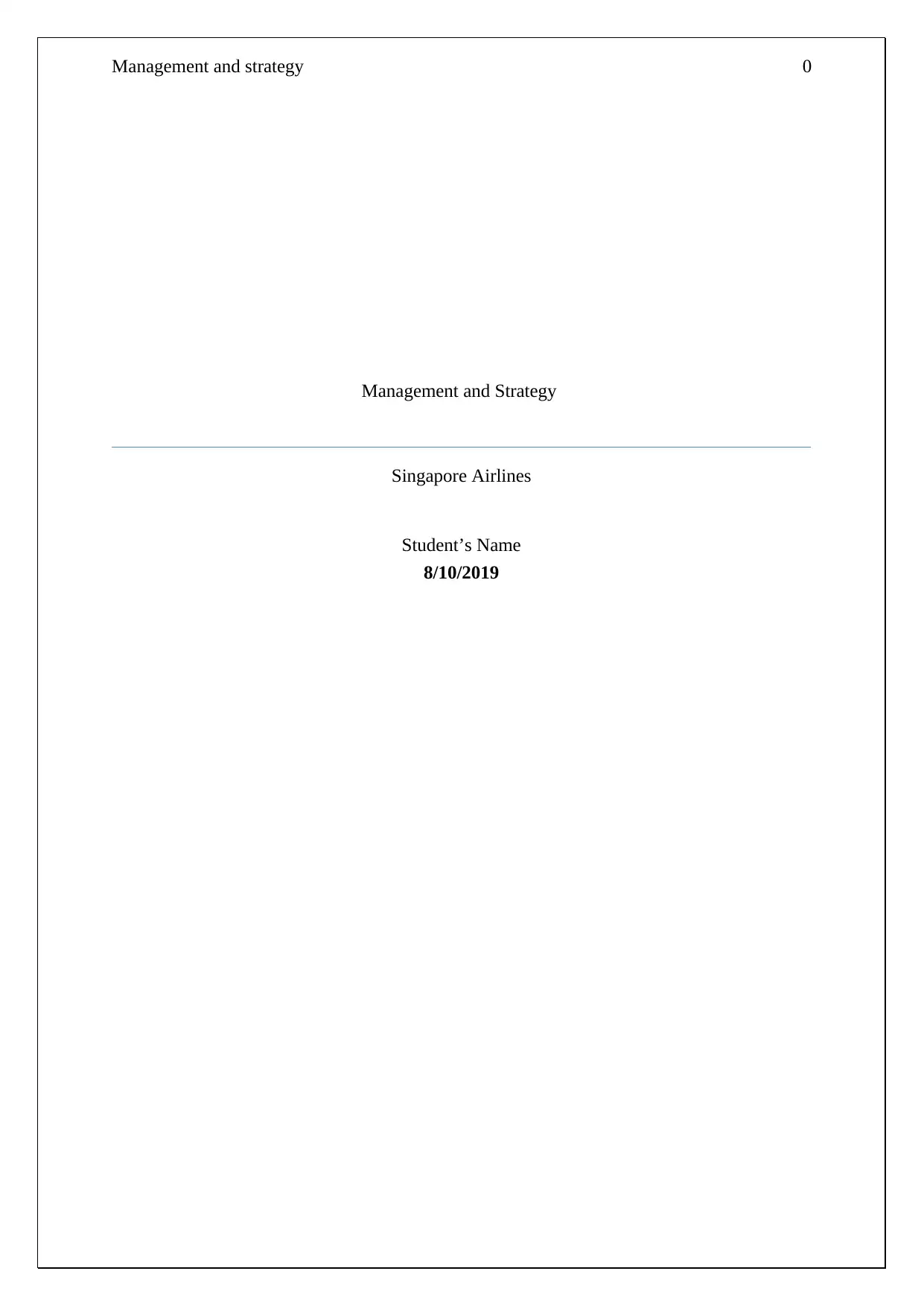
Management and strategy 0
Management and Strategy
Singapore Airlines
Student’s Name
8/10/2019
Management and Strategy
Singapore Airlines
Student’s Name
8/10/2019
Paraphrase This Document
Need a fresh take? Get an instant paraphrase of this document with our AI Paraphraser
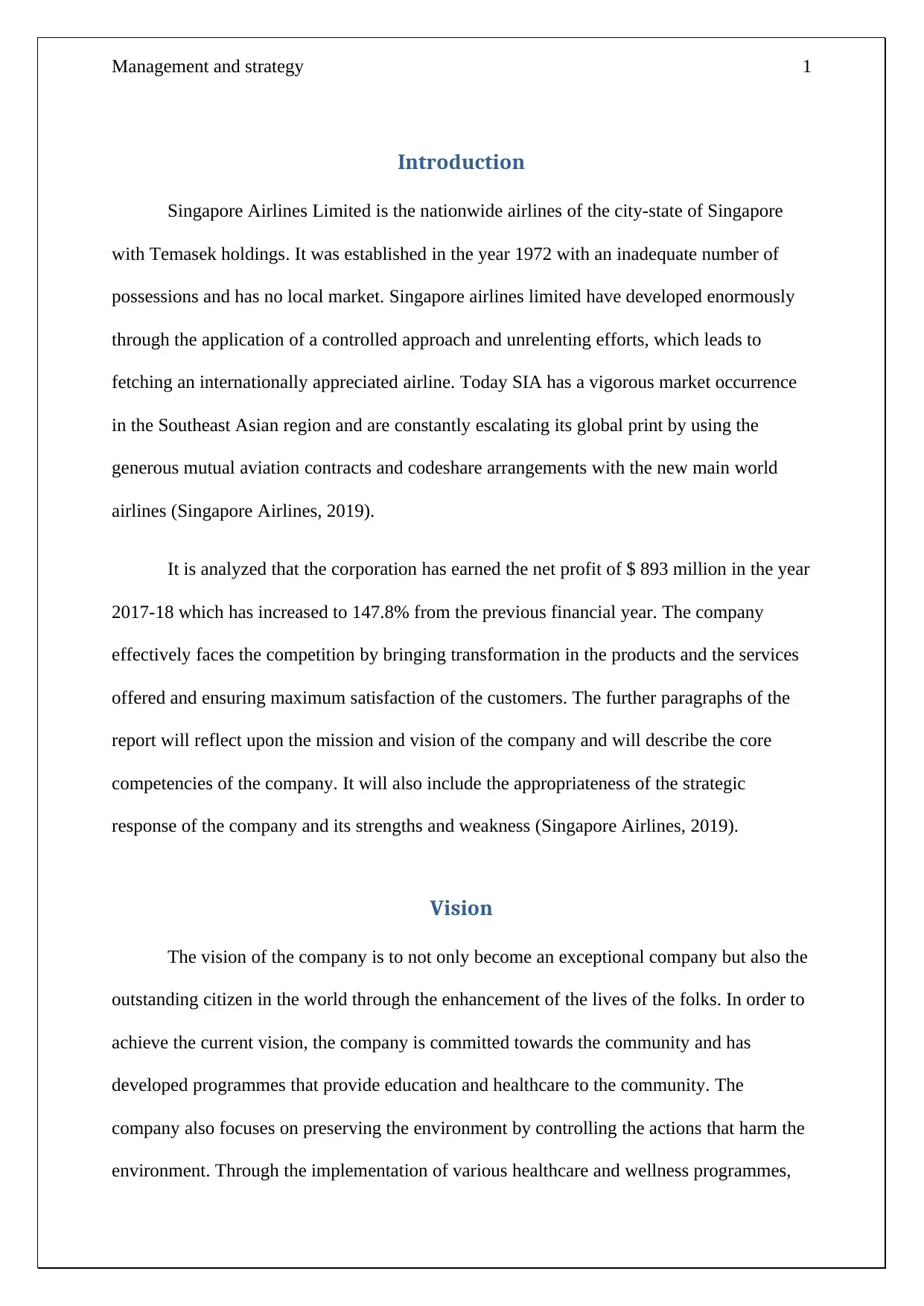
Management and strategy 1
Introduction
Singapore Airlines Limited is the nationwide airlines of the city-state of Singapore
with Temasek holdings. It was established in the year 1972 with an inadequate number of
possessions and has no local market. Singapore airlines limited have developed enormously
through the application of a controlled approach and unrelenting efforts, which leads to
fetching an internationally appreciated airline. Today SIA has a vigorous market occurrence
in the Southeast Asian region and are constantly escalating its global print by using the
generous mutual aviation contracts and codeshare arrangements with the new main world
airlines (Singapore Airlines, 2019).
It is analyzed that the corporation has earned the net profit of $ 893 million in the year
2017-18 which has increased to 147.8% from the previous financial year. The company
effectively faces the competition by bringing transformation in the products and the services
offered and ensuring maximum satisfaction of the customers. The further paragraphs of the
report will reflect upon the mission and vision of the company and will describe the core
competencies of the company. It will also include the appropriateness of the strategic
response of the company and its strengths and weakness (Singapore Airlines, 2019).
Vision
The vision of the company is to not only become an exceptional company but also the
outstanding citizen in the world through the enhancement of the lives of the folks. In order to
achieve the current vision, the company is committed towards the community and has
developed programmes that provide education and healthcare to the community. The
company also focuses on preserving the environment by controlling the actions that harm the
environment. Through the implementation of various healthcare and wellness programmes,
Introduction
Singapore Airlines Limited is the nationwide airlines of the city-state of Singapore
with Temasek holdings. It was established in the year 1972 with an inadequate number of
possessions and has no local market. Singapore airlines limited have developed enormously
through the application of a controlled approach and unrelenting efforts, which leads to
fetching an internationally appreciated airline. Today SIA has a vigorous market occurrence
in the Southeast Asian region and are constantly escalating its global print by using the
generous mutual aviation contracts and codeshare arrangements with the new main world
airlines (Singapore Airlines, 2019).
It is analyzed that the corporation has earned the net profit of $ 893 million in the year
2017-18 which has increased to 147.8% from the previous financial year. The company
effectively faces the competition by bringing transformation in the products and the services
offered and ensuring maximum satisfaction of the customers. The further paragraphs of the
report will reflect upon the mission and vision of the company and will describe the core
competencies of the company. It will also include the appropriateness of the strategic
response of the company and its strengths and weakness (Singapore Airlines, 2019).
Vision
The vision of the company is to not only become an exceptional company but also the
outstanding citizen in the world through the enhancement of the lives of the folks. In order to
achieve the current vision, the company is committed towards the community and has
developed programmes that provide education and healthcare to the community. The
company also focuses on preserving the environment by controlling the actions that harm the
environment. Through the implementation of various healthcare and wellness programmes,
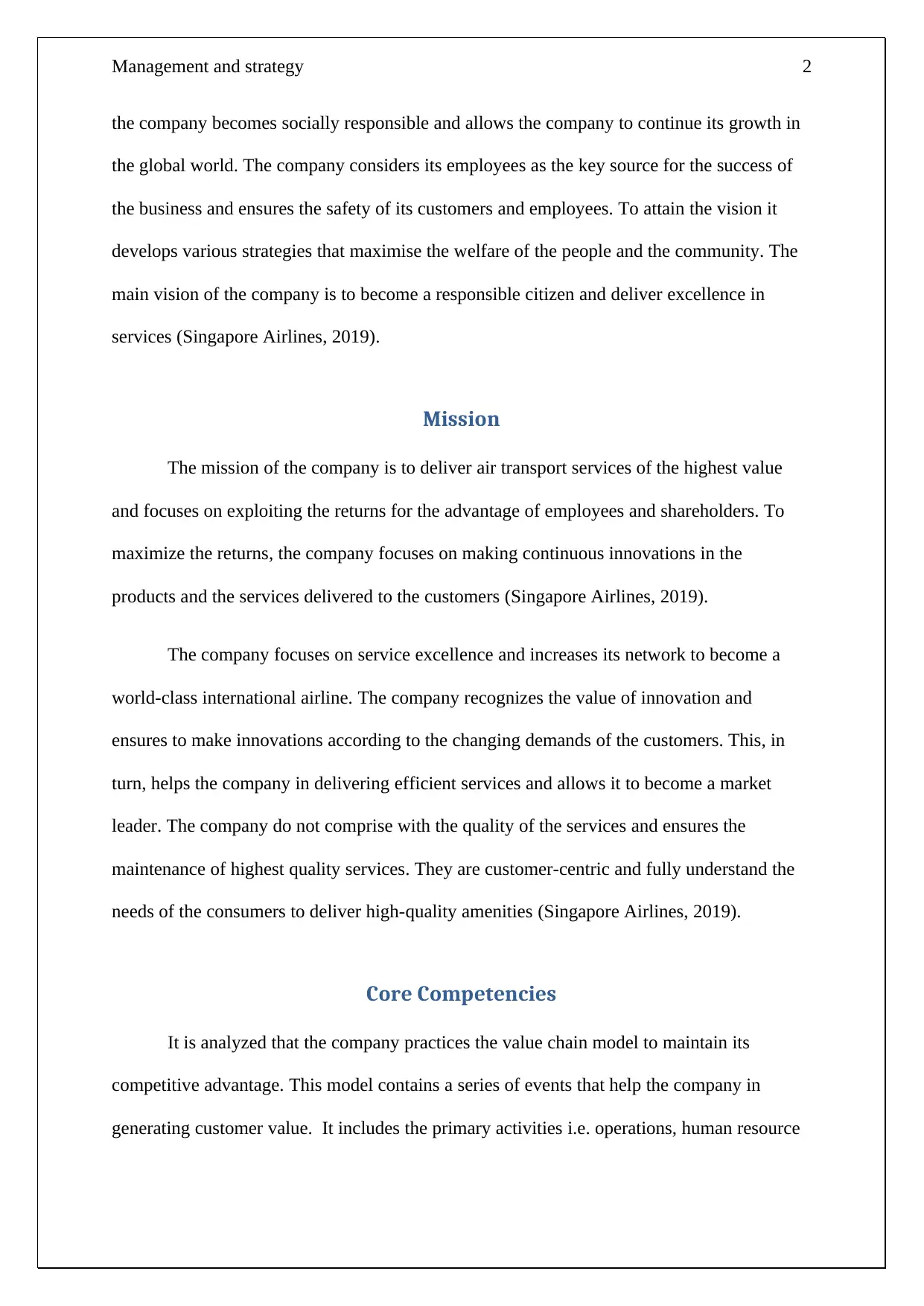
Management and strategy 2
the company becomes socially responsible and allows the company to continue its growth in
the global world. The company considers its employees as the key source for the success of
the business and ensures the safety of its customers and employees. To attain the vision it
develops various strategies that maximise the welfare of the people and the community. The
main vision of the company is to become a responsible citizen and deliver excellence in
services (Singapore Airlines, 2019).
Mission
The mission of the company is to deliver air transport services of the highest value
and focuses on exploiting the returns for the advantage of employees and shareholders. To
maximize the returns, the company focuses on making continuous innovations in the
products and the services delivered to the customers (Singapore Airlines, 2019).
The company focuses on service excellence and increases its network to become a
world-class international airline. The company recognizes the value of innovation and
ensures to make innovations according to the changing demands of the customers. This, in
turn, helps the company in delivering efficient services and allows it to become a market
leader. The company do not comprise with the quality of the services and ensures the
maintenance of highest quality services. They are customer-centric and fully understand the
needs of the consumers to deliver high-quality amenities (Singapore Airlines, 2019).
Core Competencies
It is analyzed that the company practices the value chain model to maintain its
competitive advantage. This model contains a series of events that help the company in
generating customer value. It includes the primary activities i.e. operations, human resource
the company becomes socially responsible and allows the company to continue its growth in
the global world. The company considers its employees as the key source for the success of
the business and ensures the safety of its customers and employees. To attain the vision it
develops various strategies that maximise the welfare of the people and the community. The
main vision of the company is to become a responsible citizen and deliver excellence in
services (Singapore Airlines, 2019).
Mission
The mission of the company is to deliver air transport services of the highest value
and focuses on exploiting the returns for the advantage of employees and shareholders. To
maximize the returns, the company focuses on making continuous innovations in the
products and the services delivered to the customers (Singapore Airlines, 2019).
The company focuses on service excellence and increases its network to become a
world-class international airline. The company recognizes the value of innovation and
ensures to make innovations according to the changing demands of the customers. This, in
turn, helps the company in delivering efficient services and allows it to become a market
leader. The company do not comprise with the quality of the services and ensures the
maintenance of highest quality services. They are customer-centric and fully understand the
needs of the consumers to deliver high-quality amenities (Singapore Airlines, 2019).
Core Competencies
It is analyzed that the company practices the value chain model to maintain its
competitive advantage. This model contains a series of events that help the company in
generating customer value. It includes the primary activities i.e. operations, human resource
⊘ This is a preview!⊘
Do you want full access?
Subscribe today to unlock all pages.

Trusted by 1+ million students worldwide
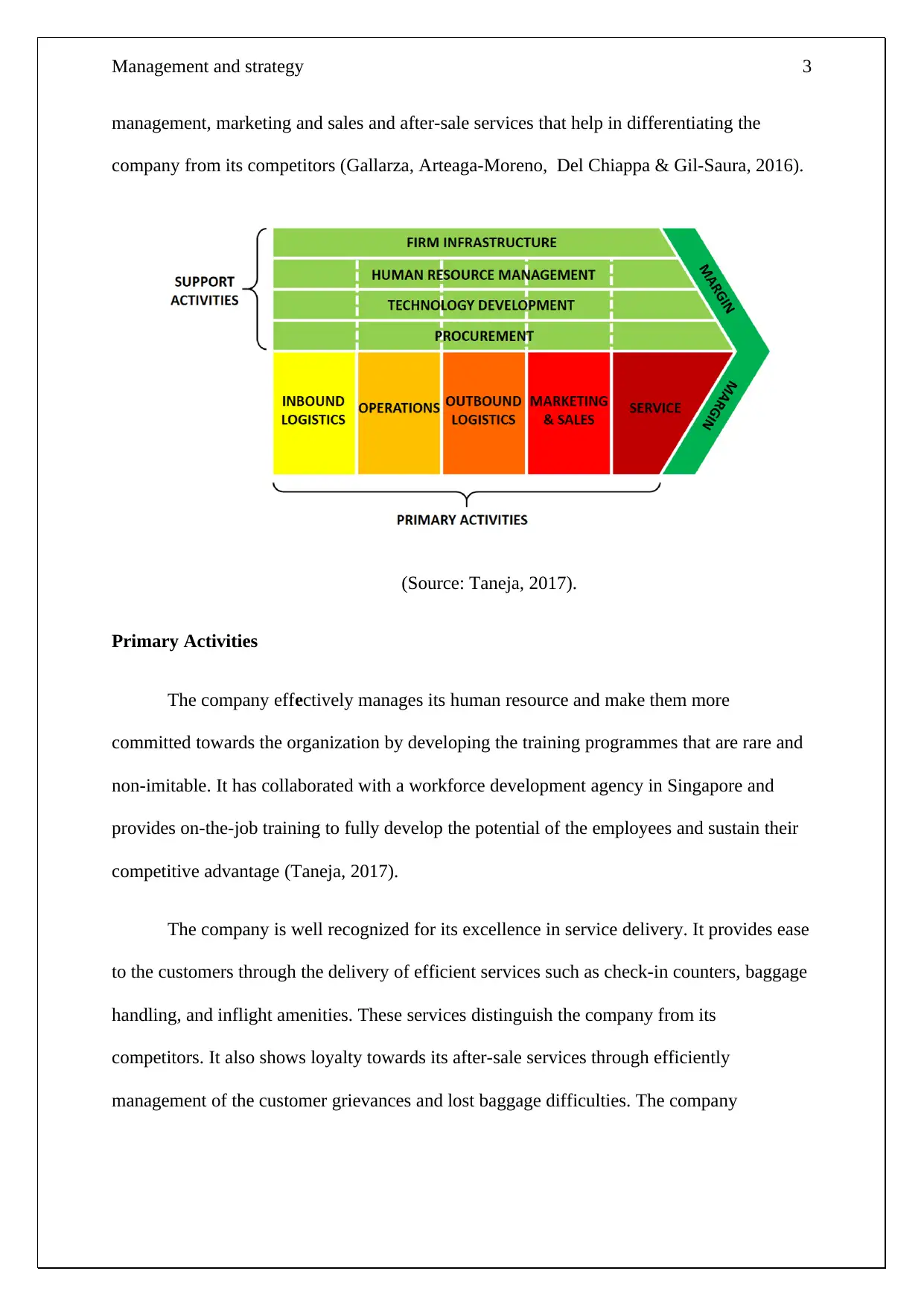
Management and strategy 3
management, marketing and sales and after-sale services that help in differentiating the
company from its competitors (Gallarza, Arteaga-Moreno, Del Chiappa & Gil-Saura, 2016).
(Source: Taneja, 2017).
Primary Activities
The company effectively manages its human resource and make them more
committed towards the organization by developing the training programmes that are rare and
non-imitable. It has collaborated with a workforce development agency in Singapore and
provides on-the-job training to fully develop the potential of the employees and sustain their
competitive advantage (Taneja, 2017).
The company is well recognized for its excellence in service delivery. It provides ease
to the customers through the delivery of efficient services such as check-in counters, baggage
handling, and inflight amenities. These services distinguish the company from its
competitors. It also shows loyalty towards its after-sale services through efficiently
management of the customer grievances and lost baggage difficulties. The company
management, marketing and sales and after-sale services that help in differentiating the
company from its competitors (Gallarza, Arteaga-Moreno, Del Chiappa & Gil-Saura, 2016).
(Source: Taneja, 2017).
Primary Activities
The company effectively manages its human resource and make them more
committed towards the organization by developing the training programmes that are rare and
non-imitable. It has collaborated with a workforce development agency in Singapore and
provides on-the-job training to fully develop the potential of the employees and sustain their
competitive advantage (Taneja, 2017).
The company is well recognized for its excellence in service delivery. It provides ease
to the customers through the delivery of efficient services such as check-in counters, baggage
handling, and inflight amenities. These services distinguish the company from its
competitors. It also shows loyalty towards its after-sale services through efficiently
management of the customer grievances and lost baggage difficulties. The company
Paraphrase This Document
Need a fresh take? Get an instant paraphrase of this document with our AI Paraphraser
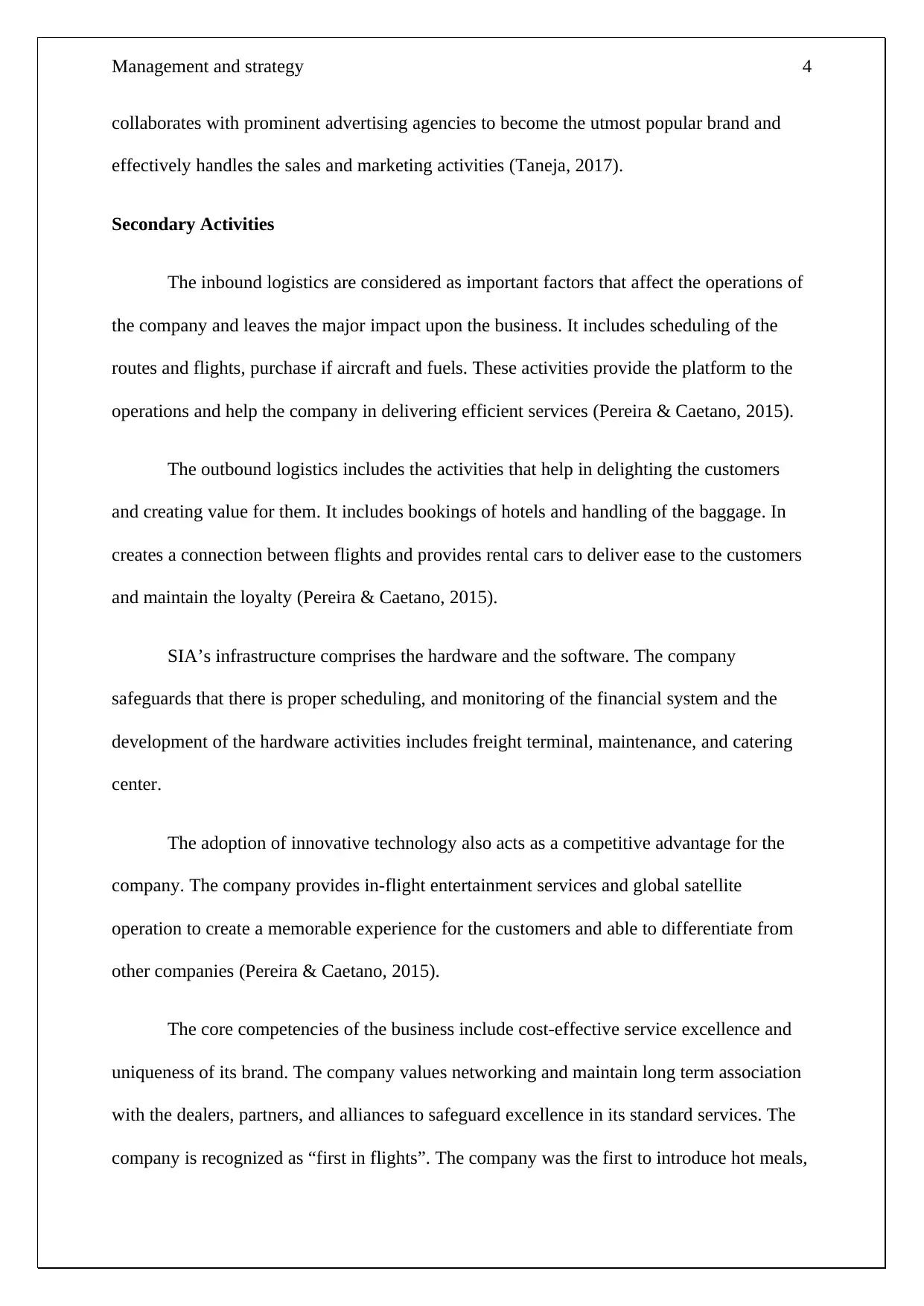
Management and strategy 4
collaborates with prominent advertising agencies to become the utmost popular brand and
effectively handles the sales and marketing activities (Taneja, 2017).
Secondary Activities
The inbound logistics are considered as important factors that affect the operations of
the company and leaves the major impact upon the business. It includes scheduling of the
routes and flights, purchase if aircraft and fuels. These activities provide the platform to the
operations and help the company in delivering efficient services (Pereira & Caetano, 2015).
The outbound logistics includes the activities that help in delighting the customers
and creating value for them. It includes bookings of hotels and handling of the baggage. In
creates a connection between flights and provides rental cars to deliver ease to the customers
and maintain the loyalty (Pereira & Caetano, 2015).
SIA’s infrastructure comprises the hardware and the software. The company
safeguards that there is proper scheduling, and monitoring of the financial system and the
development of the hardware activities includes freight terminal, maintenance, and catering
center.
The adoption of innovative technology also acts as a competitive advantage for the
company. The company provides in-flight entertainment services and global satellite
operation to create a memorable experience for the customers and able to differentiate from
other companies (Pereira & Caetano, 2015).
The core competencies of the business include cost-effective service excellence and
uniqueness of its brand. The company values networking and maintain long term association
with the dealers, partners, and alliances to safeguard excellence in its standard services. The
company is recognized as “first in flights”. The company was the first to introduce hot meals,
collaborates with prominent advertising agencies to become the utmost popular brand and
effectively handles the sales and marketing activities (Taneja, 2017).
Secondary Activities
The inbound logistics are considered as important factors that affect the operations of
the company and leaves the major impact upon the business. It includes scheduling of the
routes and flights, purchase if aircraft and fuels. These activities provide the platform to the
operations and help the company in delivering efficient services (Pereira & Caetano, 2015).
The outbound logistics includes the activities that help in delighting the customers
and creating value for them. It includes bookings of hotels and handling of the baggage. In
creates a connection between flights and provides rental cars to deliver ease to the customers
and maintain the loyalty (Pereira & Caetano, 2015).
SIA’s infrastructure comprises the hardware and the software. The company
safeguards that there is proper scheduling, and monitoring of the financial system and the
development of the hardware activities includes freight terminal, maintenance, and catering
center.
The adoption of innovative technology also acts as a competitive advantage for the
company. The company provides in-flight entertainment services and global satellite
operation to create a memorable experience for the customers and able to differentiate from
other companies (Pereira & Caetano, 2015).
The core competencies of the business include cost-effective service excellence and
uniqueness of its brand. The company values networking and maintain long term association
with the dealers, partners, and alliances to safeguard excellence in its standard services. The
company is recognized as “first in flights”. The company was the first to introduce hot meals,
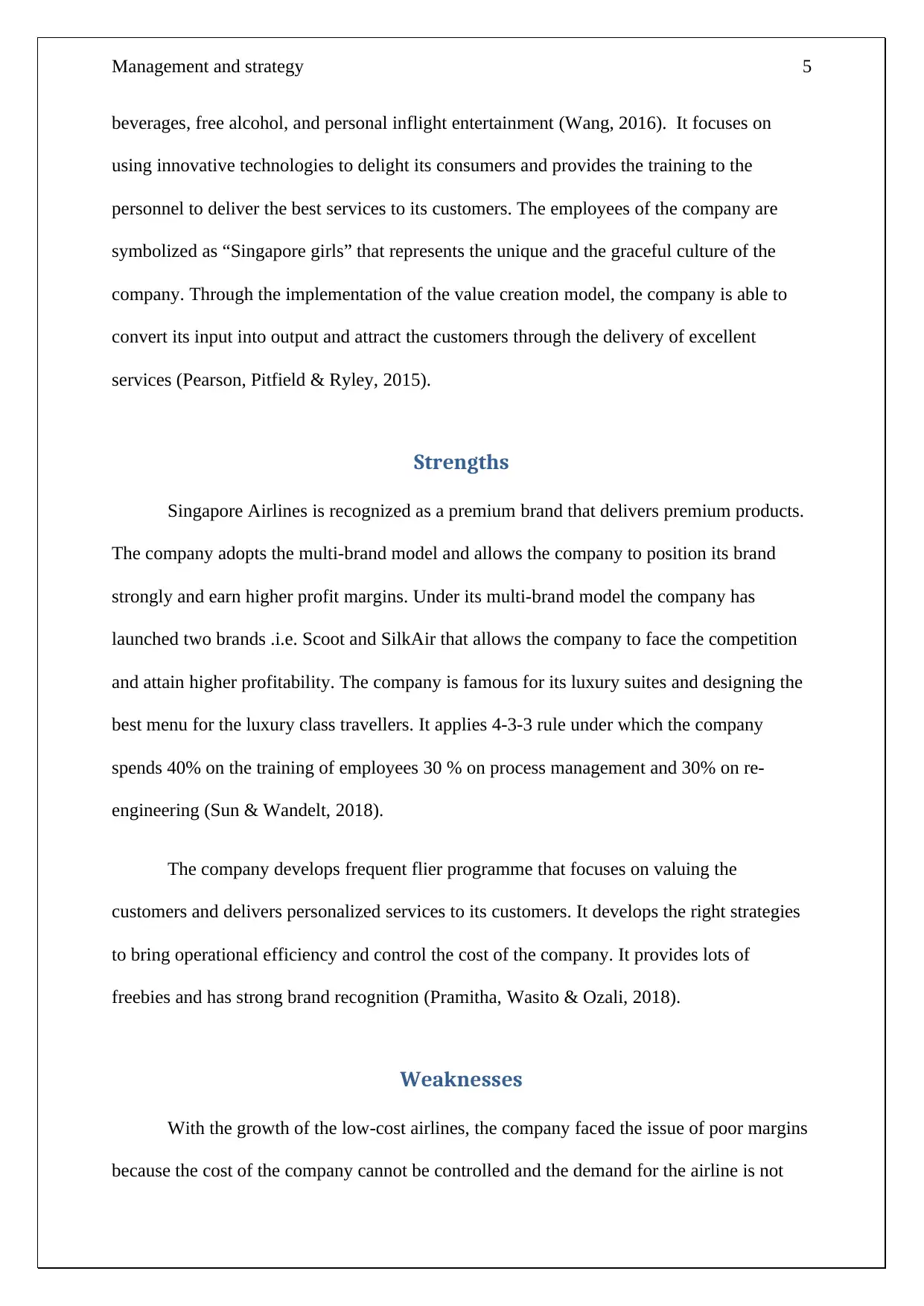
Management and strategy 5
beverages, free alcohol, and personal inflight entertainment (Wang, 2016). It focuses on
using innovative technologies to delight its consumers and provides the training to the
personnel to deliver the best services to its customers. The employees of the company are
symbolized as “Singapore girls” that represents the unique and the graceful culture of the
company. Through the implementation of the value creation model, the company is able to
convert its input into output and attract the customers through the delivery of excellent
services (Pearson, Pitfield & Ryley, 2015).
Strengths
Singapore Airlines is recognized as a premium brand that delivers premium products.
The company adopts the multi-brand model and allows the company to position its brand
strongly and earn higher profit margins. Under its multi-brand model the company has
launched two brands .i.e. Scoot and SilkAir that allows the company to face the competition
and attain higher profitability. The company is famous for its luxury suites and designing the
best menu for the luxury class travellers. It applies 4-3-3 rule under which the company
spends 40% on the training of employees 30 % on process management and 30% on re-
engineering (Sun & Wandelt, 2018).
The company develops frequent flier programme that focuses on valuing the
customers and delivers personalized services to its customers. It develops the right strategies
to bring operational efficiency and control the cost of the company. It provides lots of
freebies and has strong brand recognition (Pramitha, Wasito & Ozali, 2018).
Weaknesses
With the growth of the low-cost airlines, the company faced the issue of poor margins
because the cost of the company cannot be controlled and the demand for the airline is not
beverages, free alcohol, and personal inflight entertainment (Wang, 2016). It focuses on
using innovative technologies to delight its consumers and provides the training to the
personnel to deliver the best services to its customers. The employees of the company are
symbolized as “Singapore girls” that represents the unique and the graceful culture of the
company. Through the implementation of the value creation model, the company is able to
convert its input into output and attract the customers through the delivery of excellent
services (Pearson, Pitfield & Ryley, 2015).
Strengths
Singapore Airlines is recognized as a premium brand that delivers premium products.
The company adopts the multi-brand model and allows the company to position its brand
strongly and earn higher profit margins. Under its multi-brand model the company has
launched two brands .i.e. Scoot and SilkAir that allows the company to face the competition
and attain higher profitability. The company is famous for its luxury suites and designing the
best menu for the luxury class travellers. It applies 4-3-3 rule under which the company
spends 40% on the training of employees 30 % on process management and 30% on re-
engineering (Sun & Wandelt, 2018).
The company develops frequent flier programme that focuses on valuing the
customers and delivers personalized services to its customers. It develops the right strategies
to bring operational efficiency and control the cost of the company. It provides lots of
freebies and has strong brand recognition (Pramitha, Wasito & Ozali, 2018).
Weaknesses
With the growth of the low-cost airlines, the company faced the issue of poor margins
because the cost of the company cannot be controlled and the demand for the airline is not
⊘ This is a preview!⊘
Do you want full access?
Subscribe today to unlock all pages.

Trusted by 1+ million students worldwide
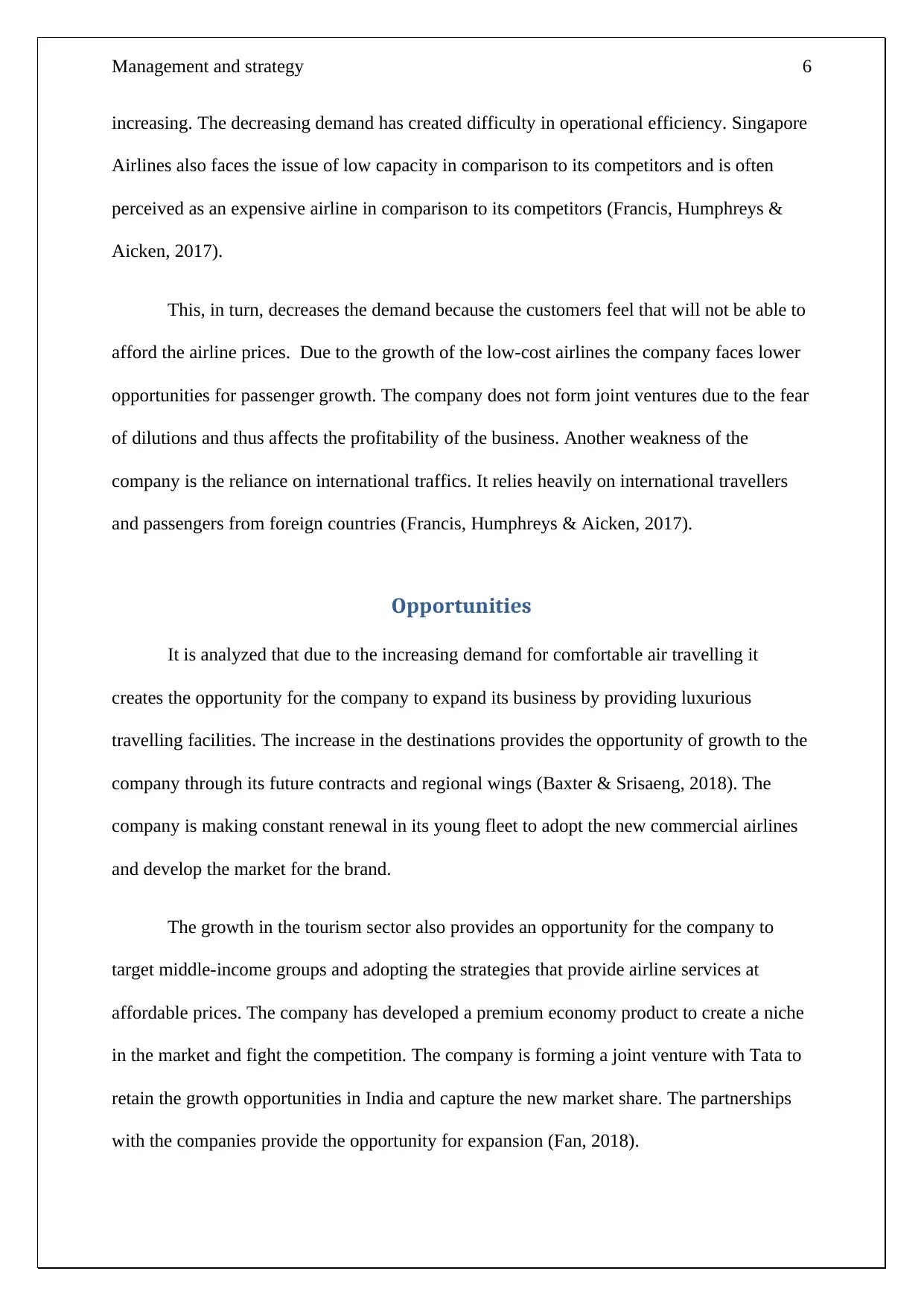
Management and strategy 6
increasing. The decreasing demand has created difficulty in operational efficiency. Singapore
Airlines also faces the issue of low capacity in comparison to its competitors and is often
perceived as an expensive airline in comparison to its competitors (Francis, Humphreys &
Aicken, 2017).
This, in turn, decreases the demand because the customers feel that will not be able to
afford the airline prices. Due to the growth of the low-cost airlines the company faces lower
opportunities for passenger growth. The company does not form joint ventures due to the fear
of dilutions and thus affects the profitability of the business. Another weakness of the
company is the reliance on international traffics. It relies heavily on international travellers
and passengers from foreign countries (Francis, Humphreys & Aicken, 2017).
Opportunities
It is analyzed that due to the increasing demand for comfortable air travelling it
creates the opportunity for the company to expand its business by providing luxurious
travelling facilities. The increase in the destinations provides the opportunity of growth to the
company through its future contracts and regional wings (Baxter & Srisaeng, 2018). The
company is making constant renewal in its young fleet to adopt the new commercial airlines
and develop the market for the brand.
The growth in the tourism sector also provides an opportunity for the company to
target middle-income groups and adopting the strategies that provide airline services at
affordable prices. The company has developed a premium economy product to create a niche
in the market and fight the competition. The company is forming a joint venture with Tata to
retain the growth opportunities in India and capture the new market share. The partnerships
with the companies provide the opportunity for expansion (Fan, 2018).
increasing. The decreasing demand has created difficulty in operational efficiency. Singapore
Airlines also faces the issue of low capacity in comparison to its competitors and is often
perceived as an expensive airline in comparison to its competitors (Francis, Humphreys &
Aicken, 2017).
This, in turn, decreases the demand because the customers feel that will not be able to
afford the airline prices. Due to the growth of the low-cost airlines the company faces lower
opportunities for passenger growth. The company does not form joint ventures due to the fear
of dilutions and thus affects the profitability of the business. Another weakness of the
company is the reliance on international traffics. It relies heavily on international travellers
and passengers from foreign countries (Francis, Humphreys & Aicken, 2017).
Opportunities
It is analyzed that due to the increasing demand for comfortable air travelling it
creates the opportunity for the company to expand its business by providing luxurious
travelling facilities. The increase in the destinations provides the opportunity of growth to the
company through its future contracts and regional wings (Baxter & Srisaeng, 2018). The
company is making constant renewal in its young fleet to adopt the new commercial airlines
and develop the market for the brand.
The growth in the tourism sector also provides an opportunity for the company to
target middle-income groups and adopting the strategies that provide airline services at
affordable prices. The company has developed a premium economy product to create a niche
in the market and fight the competition. The company is forming a joint venture with Tata to
retain the growth opportunities in India and capture the new market share. The partnerships
with the companies provide the opportunity for expansion (Fan, 2018).
Paraphrase This Document
Need a fresh take? Get an instant paraphrase of this document with our AI Paraphraser
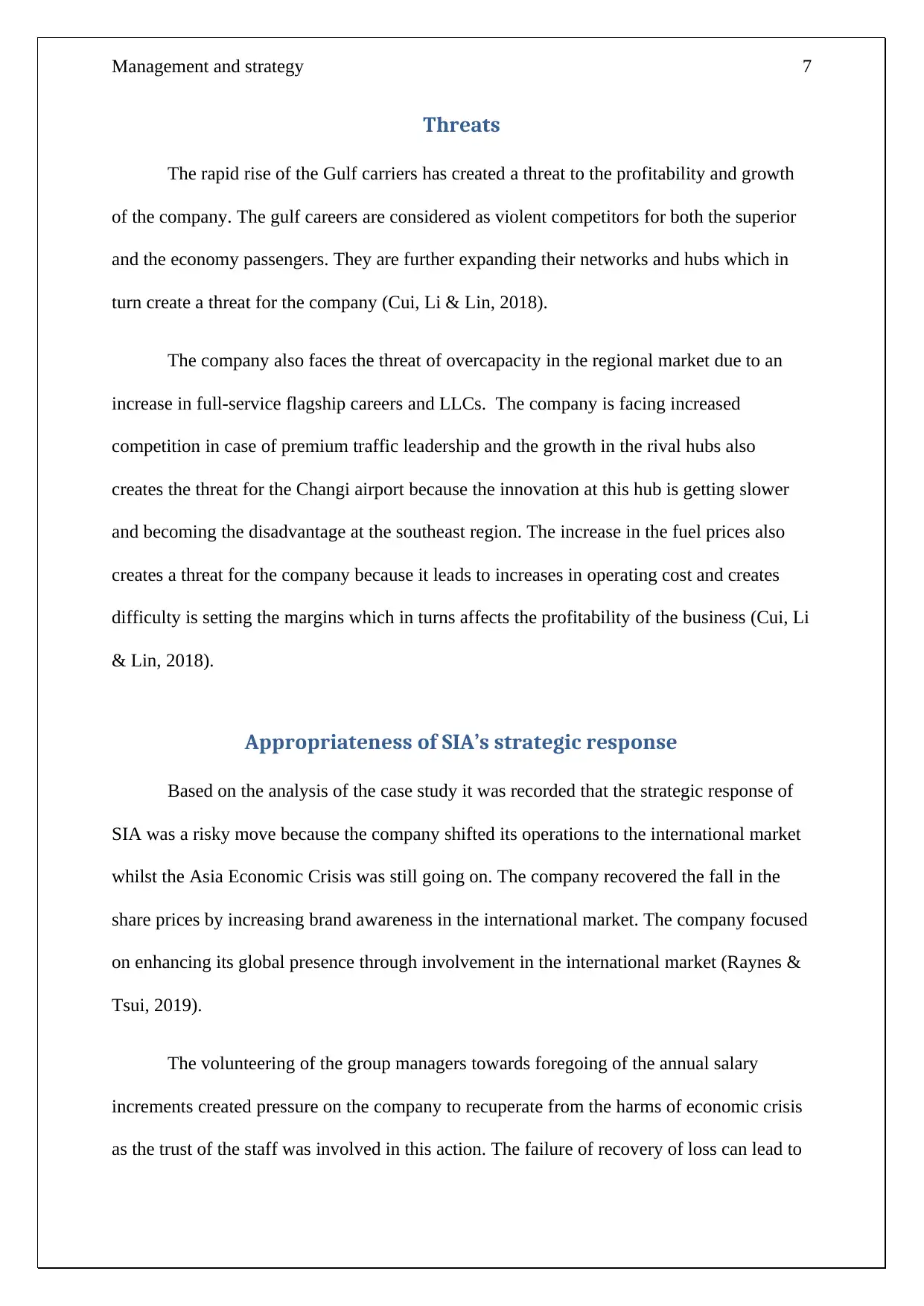
Management and strategy 7
Threats
The rapid rise of the Gulf carriers has created a threat to the profitability and growth
of the company. The gulf careers are considered as violent competitors for both the superior
and the economy passengers. They are further expanding their networks and hubs which in
turn create a threat for the company (Cui, Li & Lin, 2018).
The company also faces the threat of overcapacity in the regional market due to an
increase in full-service flagship careers and LLCs. The company is facing increased
competition in case of premium traffic leadership and the growth in the rival hubs also
creates the threat for the Changi airport because the innovation at this hub is getting slower
and becoming the disadvantage at the southeast region. The increase in the fuel prices also
creates a threat for the company because it leads to increases in operating cost and creates
difficulty is setting the margins which in turns affects the profitability of the business (Cui, Li
& Lin, 2018).
Appropriateness of SIA’s strategic response
Based on the analysis of the case study it was recorded that the strategic response of
SIA was a risky move because the company shifted its operations to the international market
whilst the Asia Economic Crisis was still going on. The company recovered the fall in the
share prices by increasing brand awareness in the international market. The company focused
on enhancing its global presence through involvement in the international market (Raynes &
Tsui, 2019).
The volunteering of the group managers towards foregoing of the annual salary
increments created pressure on the company to recuperate from the harms of economic crisis
as the trust of the staff was involved in this action. The failure of recovery of loss can lead to
Threats
The rapid rise of the Gulf carriers has created a threat to the profitability and growth
of the company. The gulf careers are considered as violent competitors for both the superior
and the economy passengers. They are further expanding their networks and hubs which in
turn create a threat for the company (Cui, Li & Lin, 2018).
The company also faces the threat of overcapacity in the regional market due to an
increase in full-service flagship careers and LLCs. The company is facing increased
competition in case of premium traffic leadership and the growth in the rival hubs also
creates the threat for the Changi airport because the innovation at this hub is getting slower
and becoming the disadvantage at the southeast region. The increase in the fuel prices also
creates a threat for the company because it leads to increases in operating cost and creates
difficulty is setting the margins which in turns affects the profitability of the business (Cui, Li
& Lin, 2018).
Appropriateness of SIA’s strategic response
Based on the analysis of the case study it was recorded that the strategic response of
SIA was a risky move because the company shifted its operations to the international market
whilst the Asia Economic Crisis was still going on. The company recovered the fall in the
share prices by increasing brand awareness in the international market. The company focused
on enhancing its global presence through involvement in the international market (Raynes &
Tsui, 2019).
The volunteering of the group managers towards foregoing of the annual salary
increments created pressure on the company to recuperate from the harms of economic crisis
as the trust of the staff was involved in this action. The failure of recovery of loss can lead to
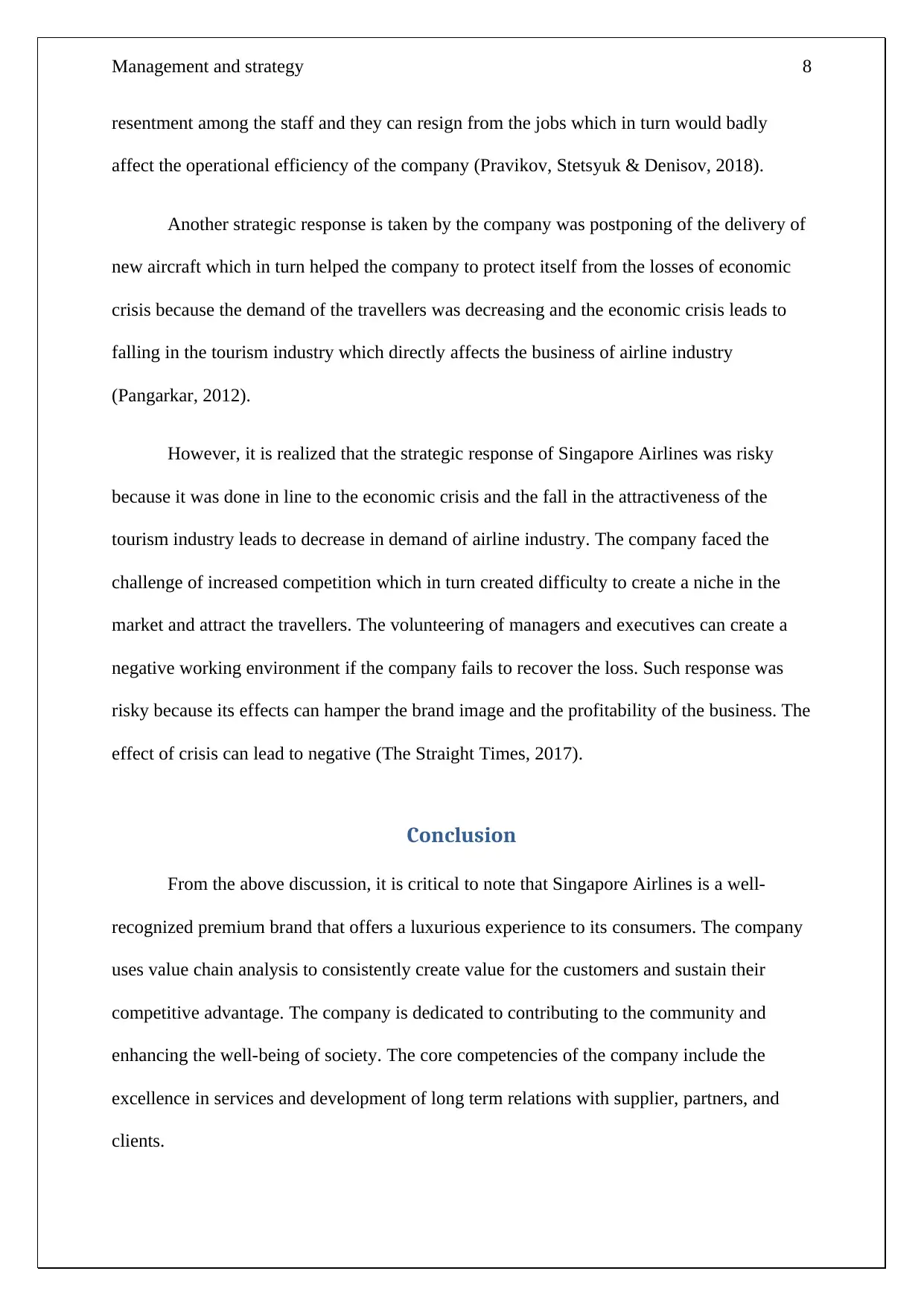
Management and strategy 8
resentment among the staff and they can resign from the jobs which in turn would badly
affect the operational efficiency of the company (Pravikov, Stetsyuk & Denisov, 2018).
Another strategic response is taken by the company was postponing of the delivery of
new aircraft which in turn helped the company to protect itself from the losses of economic
crisis because the demand of the travellers was decreasing and the economic crisis leads to
falling in the tourism industry which directly affects the business of airline industry
(Pangarkar, 2012).
However, it is realized that the strategic response of Singapore Airlines was risky
because it was done in line to the economic crisis and the fall in the attractiveness of the
tourism industry leads to decrease in demand of airline industry. The company faced the
challenge of increased competition which in turn created difficulty to create a niche in the
market and attract the travellers. The volunteering of managers and executives can create a
negative working environment if the company fails to recover the loss. Such response was
risky because its effects can hamper the brand image and the profitability of the business. The
effect of crisis can lead to negative (The Straight Times, 2017).
Conclusion
From the above discussion, it is critical to note that Singapore Airlines is a well-
recognized premium brand that offers a luxurious experience to its consumers. The company
uses value chain analysis to consistently create value for the customers and sustain their
competitive advantage. The company is dedicated to contributing to the community and
enhancing the well-being of society. The core competencies of the company include the
excellence in services and development of long term relations with supplier, partners, and
clients.
resentment among the staff and they can resign from the jobs which in turn would badly
affect the operational efficiency of the company (Pravikov, Stetsyuk & Denisov, 2018).
Another strategic response is taken by the company was postponing of the delivery of
new aircraft which in turn helped the company to protect itself from the losses of economic
crisis because the demand of the travellers was decreasing and the economic crisis leads to
falling in the tourism industry which directly affects the business of airline industry
(Pangarkar, 2012).
However, it is realized that the strategic response of Singapore Airlines was risky
because it was done in line to the economic crisis and the fall in the attractiveness of the
tourism industry leads to decrease in demand of airline industry. The company faced the
challenge of increased competition which in turn created difficulty to create a niche in the
market and attract the travellers. The volunteering of managers and executives can create a
negative working environment if the company fails to recover the loss. Such response was
risky because its effects can hamper the brand image and the profitability of the business. The
effect of crisis can lead to negative (The Straight Times, 2017).
Conclusion
From the above discussion, it is critical to note that Singapore Airlines is a well-
recognized premium brand that offers a luxurious experience to its consumers. The company
uses value chain analysis to consistently create value for the customers and sustain their
competitive advantage. The company is dedicated to contributing to the community and
enhancing the well-being of society. The core competencies of the company include the
excellence in services and development of long term relations with supplier, partners, and
clients.
⊘ This is a preview!⊘
Do you want full access?
Subscribe today to unlock all pages.

Trusted by 1+ million students worldwide
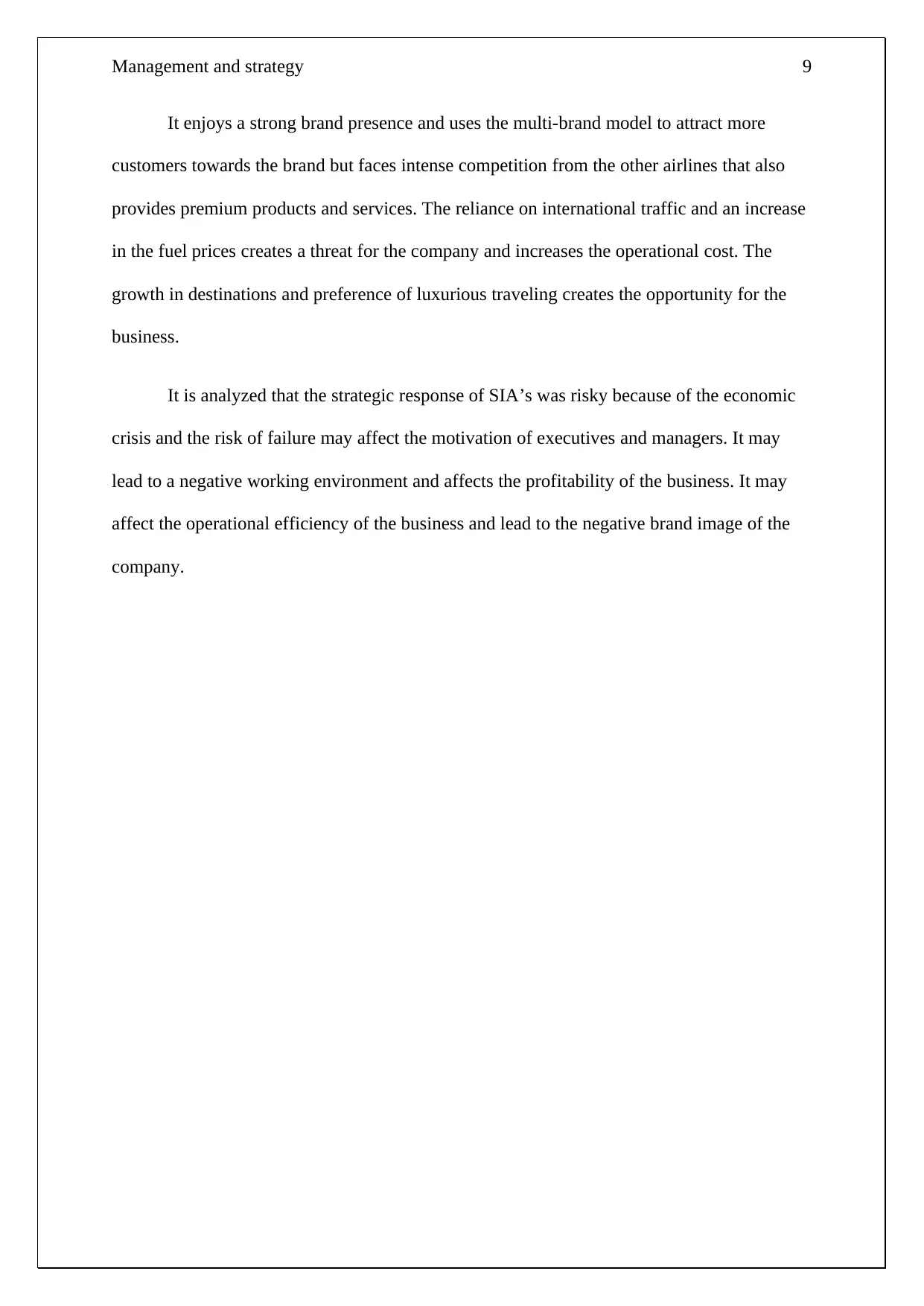
Management and strategy 9
It enjoys a strong brand presence and uses the multi-brand model to attract more
customers towards the brand but faces intense competition from the other airlines that also
provides premium products and services. The reliance on international traffic and an increase
in the fuel prices creates a threat for the company and increases the operational cost. The
growth in destinations and preference of luxurious traveling creates the opportunity for the
business.
It is analyzed that the strategic response of SIA’s was risky because of the economic
crisis and the risk of failure may affect the motivation of executives and managers. It may
lead to a negative working environment and affects the profitability of the business. It may
affect the operational efficiency of the business and lead to the negative brand image of the
company.
It enjoys a strong brand presence and uses the multi-brand model to attract more
customers towards the brand but faces intense competition from the other airlines that also
provides premium products and services. The reliance on international traffic and an increase
in the fuel prices creates a threat for the company and increases the operational cost. The
growth in destinations and preference of luxurious traveling creates the opportunity for the
business.
It is analyzed that the strategic response of SIA’s was risky because of the economic
crisis and the risk of failure may affect the motivation of executives and managers. It may
lead to a negative working environment and affects the profitability of the business. It may
affect the operational efficiency of the business and lead to the negative brand image of the
company.
Paraphrase This Document
Need a fresh take? Get an instant paraphrase of this document with our AI Paraphraser
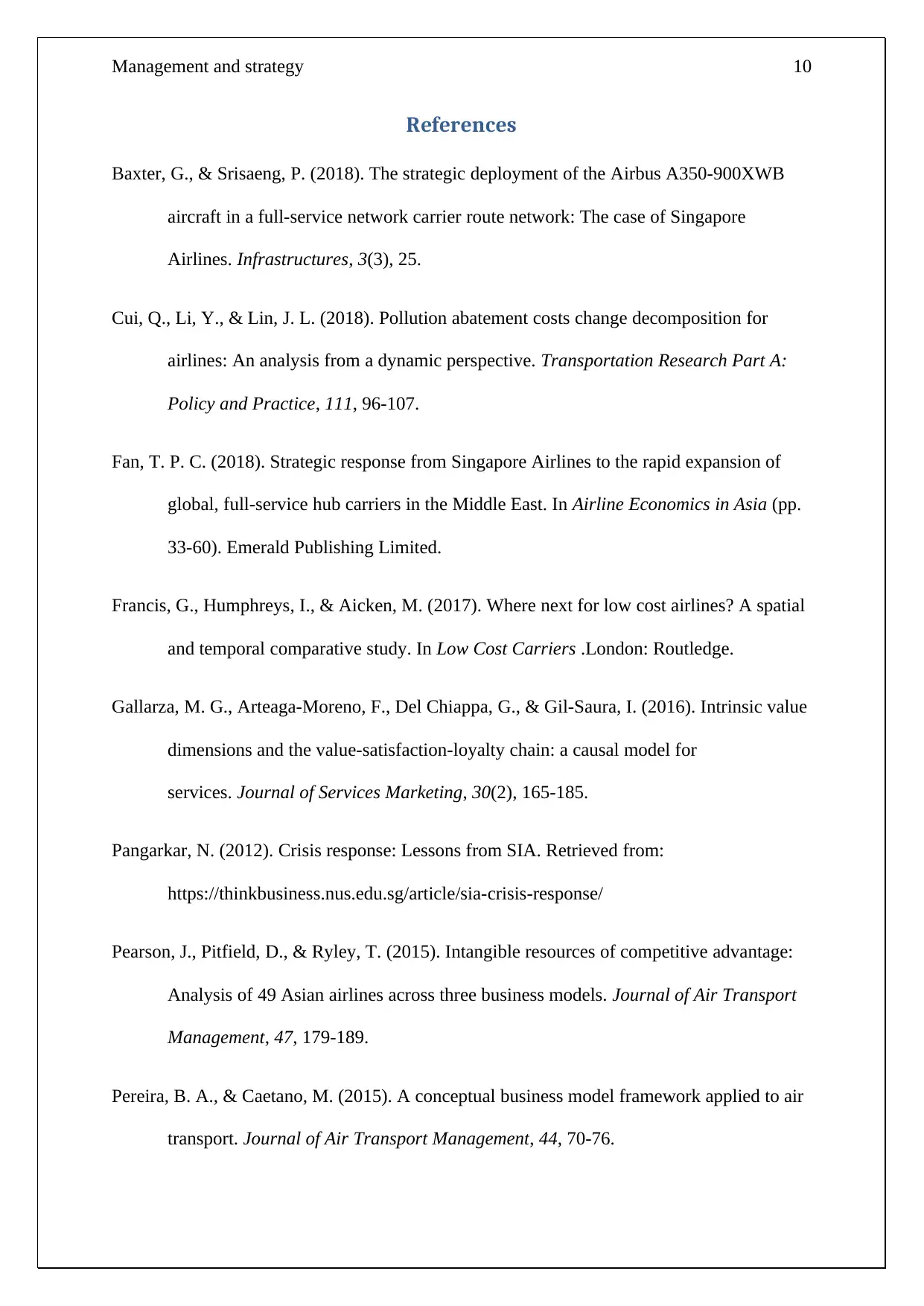
Management and strategy 10
References
Baxter, G., & Srisaeng, P. (2018). The strategic deployment of the Airbus A350-900XWB
aircraft in a full-service network carrier route network: The case of Singapore
Airlines. Infrastructures, 3(3), 25.
Cui, Q., Li, Y., & Lin, J. L. (2018). Pollution abatement costs change decomposition for
airlines: An analysis from a dynamic perspective. Transportation Research Part A:
Policy and Practice, 111, 96-107.
Fan, T. P. C. (2018). Strategic response from Singapore Airlines to the rapid expansion of
global, full-service hub carriers in the Middle East. In Airline Economics in Asia (pp.
33-60). Emerald Publishing Limited.
Francis, G., Humphreys, I., & Aicken, M. (2017). Where next for low cost airlines? A spatial
and temporal comparative study. In Low Cost Carriers .London: Routledge.
Gallarza, M. G., Arteaga-Moreno, F., Del Chiappa, G., & Gil-Saura, I. (2016). Intrinsic value
dimensions and the value-satisfaction-loyalty chain: a causal model for
services. Journal of Services Marketing, 30(2), 165-185.
Pangarkar, N. (2012). Crisis response: Lessons from SIA. Retrieved from:
https://thinkbusiness.nus.edu.sg/article/sia-crisis-response/
Pearson, J., Pitfield, D., & Ryley, T. (2015). Intangible resources of competitive advantage:
Analysis of 49 Asian airlines across three business models. Journal of Air Transport
Management, 47, 179-189.
Pereira, B. A., & Caetano, M. (2015). A conceptual business model framework applied to air
transport. Journal of Air Transport Management, 44, 70-76.
References
Baxter, G., & Srisaeng, P. (2018). The strategic deployment of the Airbus A350-900XWB
aircraft in a full-service network carrier route network: The case of Singapore
Airlines. Infrastructures, 3(3), 25.
Cui, Q., Li, Y., & Lin, J. L. (2018). Pollution abatement costs change decomposition for
airlines: An analysis from a dynamic perspective. Transportation Research Part A:
Policy and Practice, 111, 96-107.
Fan, T. P. C. (2018). Strategic response from Singapore Airlines to the rapid expansion of
global, full-service hub carriers in the Middle East. In Airline Economics in Asia (pp.
33-60). Emerald Publishing Limited.
Francis, G., Humphreys, I., & Aicken, M. (2017). Where next for low cost airlines? A spatial
and temporal comparative study. In Low Cost Carriers .London: Routledge.
Gallarza, M. G., Arteaga-Moreno, F., Del Chiappa, G., & Gil-Saura, I. (2016). Intrinsic value
dimensions and the value-satisfaction-loyalty chain: a causal model for
services. Journal of Services Marketing, 30(2), 165-185.
Pangarkar, N. (2012). Crisis response: Lessons from SIA. Retrieved from:
https://thinkbusiness.nus.edu.sg/article/sia-crisis-response/
Pearson, J., Pitfield, D., & Ryley, T. (2015). Intangible resources of competitive advantage:
Analysis of 49 Asian airlines across three business models. Journal of Air Transport
Management, 47, 179-189.
Pereira, B. A., & Caetano, M. (2015). A conceptual business model framework applied to air
transport. Journal of Air Transport Management, 44, 70-76.
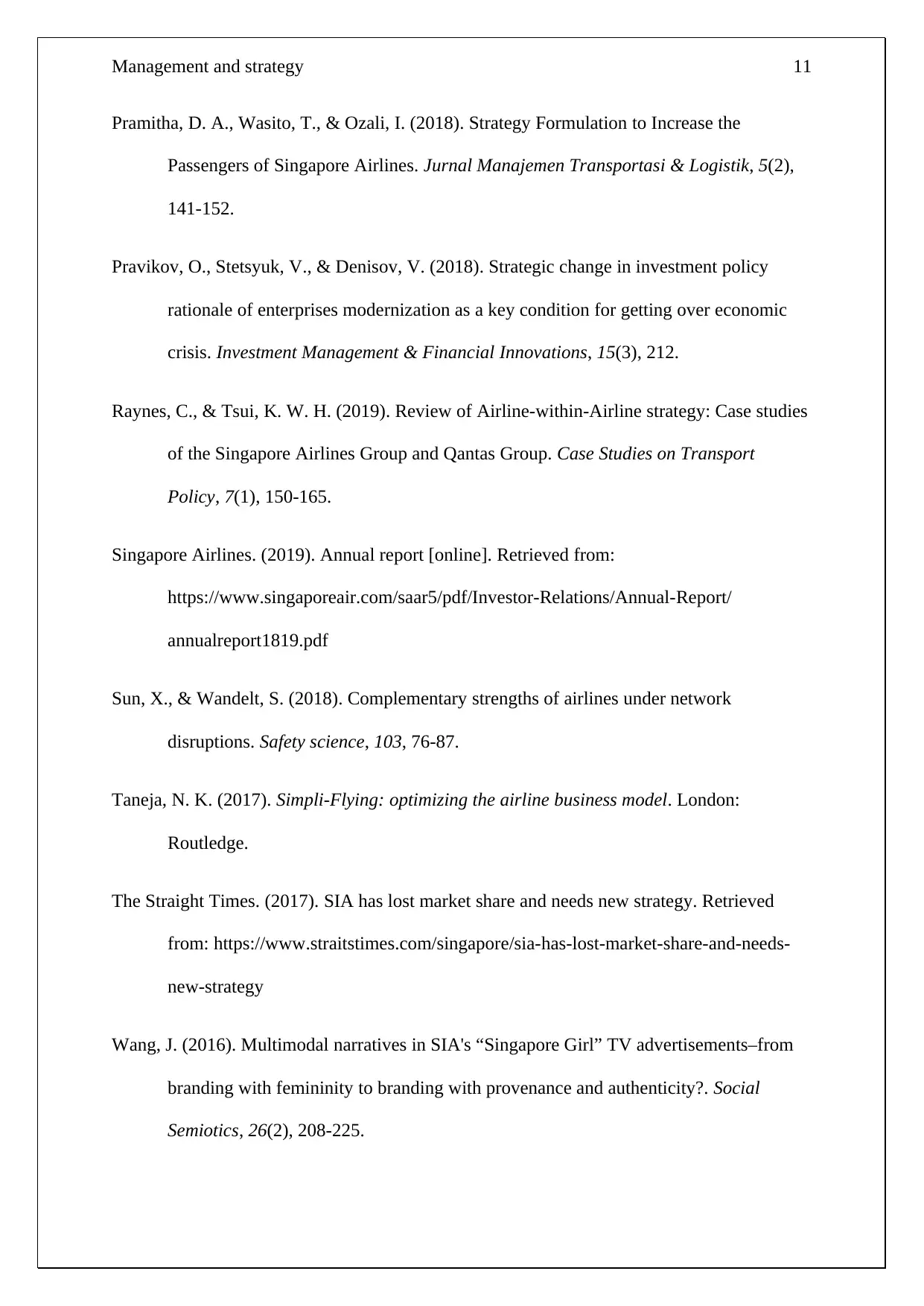
Management and strategy 11
Pramitha, D. A., Wasito, T., & Ozali, I. (2018). Strategy Formulation to Increase the
Passengers of Singapore Airlines. Jurnal Manajemen Transportasi & Logistik, 5(2),
141-152.
Pravikov, O., Stetsyuk, V., & Denisov, V. (2018). Strategic change in investment policy
rationale of enterprises modernization as a key condition for getting over economic
crisis. Investment Management & Financial Innovations, 15(3), 212.
Raynes, C., & Tsui, K. W. H. (2019). Review of Airline-within-Airline strategy: Case studies
of the Singapore Airlines Group and Qantas Group. Case Studies on Transport
Policy, 7(1), 150-165.
Singapore Airlines. (2019). Annual report [online]. Retrieved from:
https://www.singaporeair.com/saar5/pdf/Investor-Relations/Annual-Report/
annualreport1819.pdf
Sun, X., & Wandelt, S. (2018). Complementary strengths of airlines under network
disruptions. Safety science, 103, 76-87.
Taneja, N. K. (2017). Simpli-Flying: optimizing the airline business model. London:
Routledge.
The Straight Times. (2017). SIA has lost market share and needs new strategy. Retrieved
from: https://www.straitstimes.com/singapore/sia-has-lost-market-share-and-needs-
new-strategy
Wang, J. (2016). Multimodal narratives in SIA's “Singapore Girl” TV advertisements–from
branding with femininity to branding with provenance and authenticity?. Social
Semiotics, 26(2), 208-225.
Pramitha, D. A., Wasito, T., & Ozali, I. (2018). Strategy Formulation to Increase the
Passengers of Singapore Airlines. Jurnal Manajemen Transportasi & Logistik, 5(2),
141-152.
Pravikov, O., Stetsyuk, V., & Denisov, V. (2018). Strategic change in investment policy
rationale of enterprises modernization as a key condition for getting over economic
crisis. Investment Management & Financial Innovations, 15(3), 212.
Raynes, C., & Tsui, K. W. H. (2019). Review of Airline-within-Airline strategy: Case studies
of the Singapore Airlines Group and Qantas Group. Case Studies on Transport
Policy, 7(1), 150-165.
Singapore Airlines. (2019). Annual report [online]. Retrieved from:
https://www.singaporeair.com/saar5/pdf/Investor-Relations/Annual-Report/
annualreport1819.pdf
Sun, X., & Wandelt, S. (2018). Complementary strengths of airlines under network
disruptions. Safety science, 103, 76-87.
Taneja, N. K. (2017). Simpli-Flying: optimizing the airline business model. London:
Routledge.
The Straight Times. (2017). SIA has lost market share and needs new strategy. Retrieved
from: https://www.straitstimes.com/singapore/sia-has-lost-market-share-and-needs-
new-strategy
Wang, J. (2016). Multimodal narratives in SIA's “Singapore Girl” TV advertisements–from
branding with femininity to branding with provenance and authenticity?. Social
Semiotics, 26(2), 208-225.
⊘ This is a preview!⊘
Do you want full access?
Subscribe today to unlock all pages.

Trusted by 1+ million students worldwide
1 out of 12
Related Documents
Your All-in-One AI-Powered Toolkit for Academic Success.
+13062052269
info@desklib.com
Available 24*7 on WhatsApp / Email
![[object Object]](/_next/static/media/star-bottom.7253800d.svg)
Unlock your academic potential
Copyright © 2020–2025 A2Z Services. All Rights Reserved. Developed and managed by ZUCOL.




